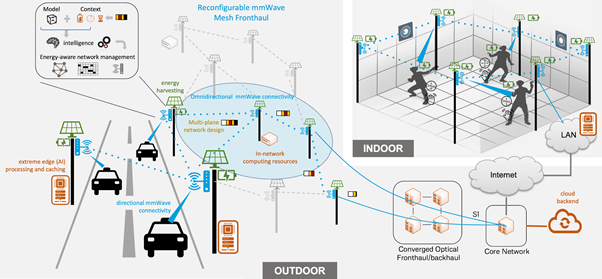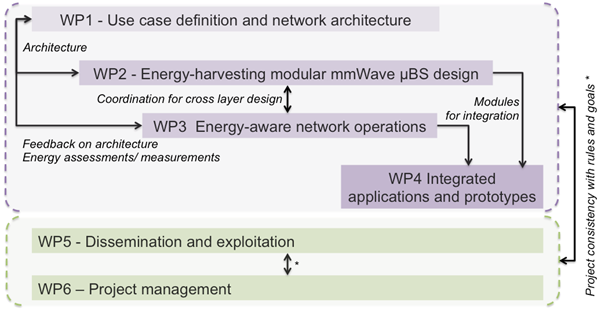Project approach
General approach
The general SAMBAS project vision centres around a holistic approach in building more sustainable mmWave networks, jointly considering radical innovations at radio, network, and service levels. As a core component, SAMBAS envisions a novel sustainable mmWave µBS that relies on harvesting of renewable energy to significantly reduce the non-renewable energy footprint of future critical high data rate ICT applications that require Gbps wireless connectivity at millisecond latency. For this, SAMBAS will combine (i) hybrid energy harvesting and supercapacitor storage, with (ii) mmWave hardware and firmware with significantly improved energy efficiency. This allows the µBS to reduce its reliance on the (mostly) non-renewable power grid, and even to temporarily run solely on battery power with peak-powering capacity. The µBS becomes the building block of a mesh network revisiting networking principles to achieve less signalling, more decentralization and tighter integration with applications to enable better decision-making for energy-aware operation. Along with energy-aware edge resource allocation, this supports the temporary and flexible deployment of cable-free energy-harvesting mmWave infrastructure, which combines multiple µBSs and the edge cloud into a sustainable infrastructure for critical high data rate ICT applications.

Use cases
The proposed SAMBAS mmWave network solution will combine first-class sustainability and energy efficiency with (beyond) 5G performance in terms of data rates (up to tens of gigabits per second) and latency (from a few to less than one millisecond). A range of future critical ICT applications are expected to require the transmission of high volumes of data at millisecond latencies, including industrial collaborative robot swarms, autonomous vehicles, and virtual reality interactions. In SAMBAS, we have selected one indoor and one outdoor ICT application to validate the proposed sustainable mmWave network solution.
Indoor interactive virtual reality (VR): Multiple VR users, wearing head-mounted displays (HMDs) walk around an open indoor space, sharing the same virtual environment. Physical movements and gestures are captured using sensors in real-time and shown in the virtual world. HMDs are wirelessly connected via mmWave for VR content streaming, with several mmWave µBSs flexibly positioned around the room for full wireless mesh coverage and harvesting natural/artificial indoor light combined with battery or external power. The main BS connects to edge cloud computing infrastructure that processes sensor inputs and renders VR content for users. Guaranteed 20ms round-trip time (inc. capture, compute, transmission, & rendering) avoids motion sickness, and 5Gbps data rate per user for 4K content.
Outdoor vehicular communication in dense areas: In a dense urban area, vehicles are connected to the cellular network through many directional antennas (RRHs) providing last mile vehicle connectivity and fronthaul network coverage. Vehicles are equipped with high data rate sensors (high-definition cameras, LIDAR, sonars, etc.) for autonomous, assisted, or remote driving. The collected data can be processed in the vehicle if resources are available and in most cases at the network level. Data needs to be streamed and processed either at the network edge or at Cloud level via the fronthaul network. Results (vehicle command, alert message, …) are sent back to the vehicle itself, to other vehicles or to other entities such as a remote driver or highway management authority. The traditional fibre link connectivity of the fronthaul network is replaced by high data rate mmWave links in a mesh of µBSs.
Work plan

